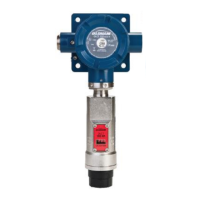OLCT 700/710 TP
OLCT 700/710 TP Instruction Manual Rev. C.1 Page 7 of 45
When possible mount the detector in an area void of high wind, accumulating dust, rain or splashing from
hose spray, direct steam releases, and continuous vibration. If the detector cannot be mounted away from
these conditions then make sure the Oldham Harsh Environment Splashguard accessory is used (PN DET-
943-002273-000).
Do not mount in locations where temperatures will exceed the operating temperature limits of the detector.
Where direct sunlight leads to exceeding the high temperature-operating limit, use a sunshade to help
reduce temperature.
2.4 Sensor Contaminants and Interference
Solid State H
2
S sensors may be adversely affected by exposure to certain airborne substances. Loss of
sensitivity or corrosion may be gradual if such materials are present in sufficient concentrations.
The more common materials that potentially cause problems with the sensors are as follows:
• Silicone vapors such as those found in greases and lubricants
• Halide Compounds containing Chlorine, Chlorine Dioxide, Fluorine, HF, HCl, and Bromine
• Caustic and Acid liquids and concentrated vapors
• Heavy metals such as tetraethyl lead
The presence of such contaminants in an area does not preclude the use of this H
2
S sensor technology,
although it is likely that the sensor lifetime will be shorter as a result. Use of this sensor in these
environments may require more frequent calibration checks to ensure safe system performance.
Solid State H
2
S sensors require O
2
in the background gas and the reading is affected by changing O
2
levels.
Interference Data
There are some gases typically found in industrial environments that can cause a cross-interference
response on the sensor. See the Table below for some examples.
Table 1: Cross Interference Gases

